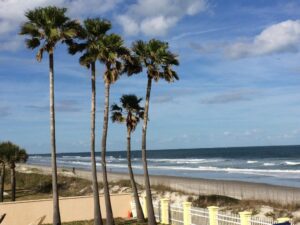 Winter is the coldest season of the year and we folks in the Northern Hemisphere are currently in the midst of it. Although every state in the nation experiences lower temperatures, some experience more severe winters than others. Thus, at this time of the year snowbirds flocks to warmer locations such as Florida and so will we!
Winter is the coldest season of the year and we folks in the Northern Hemisphere are currently in the midst of it. Although every state in the nation experiences lower temperatures, some experience more severe winters than others. Thus, at this time of the year snowbirds flocks to warmer locations such as Florida and so will we!
Business Climate
Speaking of warmer locations, Miami, Tampa, and Orlando have the highest daily mean temperatures of large US cities in December, January and February. In fact, the state’s average annual temperature (70.7 degrees Fahrenheit) is ranked the highest in the nation. The weather of the “Sunshine State” contributes to the two largest industries in Florida; Tourism and Agriculture.
Florida’s tourism is backed by its 1,260 miles of coastline and beaches and several amusement parks (the largest being the Walt Disney World Resort). In 2013, 94.7 million tourists visited Florida, breaking the last year’s record of 91.5 million. During this time, visitors spent more than $76 billion, making up 23% of the state’s sales tax revenue. The tourism industry has over 1 million employees and the ratio of visitors to employees is 85 to 1. Florida Governor Rick Scott wants to continue and build the success of this industry. In June 2014, Scott signed the “It’s Your Money Tax Budget Cut,” which was enacted to save Florida residents $500 million in tax cuts and making strategic investments to continue adding jobs and opportunities. One of these investments includes $100 million to VISIT Florida, the state’s official tourism marketing corporation, for tourism marketing efforts since a growing industry means more jobs for Florida residents.
The state has over 9.2 million acres of farmland and over 2 million employees working within the agriculture industry. Along with great sunshine, the state also has the highest average precipitation of any state. The state ranks second behind California in fresh market vegetable production. Florida accounts for 70% of the annual US production of citrus. In 2013, 430,000 acres of land was harvested for oranges and in 2012 the state had over $1.5 billion in the sales of oranges.
Taxes
According to the 2015 State Business Tax Climate Index by the Tax Foundation, Florida has one of the most favorable tax climates in the nation, ranking 5th overall. One reason for a high rating includes the absence of an individual income tax. The state’s main source of tax revenue is from the sales tax, which has a rate of 6.00% and depending on the local municipality can reach up to 7.50%. Of the state’s total $32 billion of taxes collected in FYE 2013, about $20 billion came from sales tax.
There is a corporate income tax rate of 5.50% and made up $2 billion of the FYE 2013 tax revenues. Other taxes collected included fuel taxes ($2.6 billion), beverage and tobacco taxes ($1.7 billion), and the documentary stamp tax ($1.6 billion).
Tax Credits and Incentives
Florida has several tax credits and incentives programs that are offered to businesses within the state. Here are a few programs that businesses can take advantage of.
Sales and Use Tax Exemption for Purchases of Industrial Machinery and Equipment: A total exemption from sales and use tax is available for the purchase of industrial machinery and equipment by an eligible manufacturing business. The business must manufacture, process, compound, or produce tangible personal property. To be considered an eligible manufacturing business the company must prove that it is operating within the appropriate NAICS code. In order to qualify for the exemption, the purchaser must present the seller an exemption certificate.
Florida’s Enterprise Zone Program: Administered by the Florida Department of Economic Opportunity, the Enterprise Zone program promotes economic growth and investment in distressed areas by offering several tax credits and incentives to Florida businesses located within these areas. The program is for sales tax and corporate income tax files.
Enterprise Zone Jobs Credit This credit is for corporations that increase the number of full-time jobs (36 hours/week) and hire qualified new employees. A qualified new employee must also live within the Enterprise Zone. The total credit awarded is based on a percentage (depending on the circumstances range from 20-45%) of new employee total wages during a taxable year. The business must receive certification from the enterprise zone coordinator and must be submitted with the business’ corporate income tax return. The credit can be used against corporate income tax and can be claimed up to 24 months. The exact same program is available for using credits against sales tax, but a taxpayer can only choose to utilize one of these.
Community Contribution Tax Credit: Florida businesses that donate cash, property or goods to approved projects (community development and house projects for low-income persons) can apply for either a refund of sales tax or tax credit equivalent to 50% of the value of the donation. The limit for the credit or refund is $200,000. Unused corporate income tax credits can be carried forward 5 years and unused sales tax refunds may be claimed up to 3 years after the first refund application.
Random Florida Facts
- Orlando has more visitors than any other amusement park destination in the United States.
- Gatorade, formulated in 1965, was named for the University of Florida Gators where the drink was first developed.
- Key West has the highest average temperature in the United States.
- The only Everglades (tropical wetlands) eco-system in the world is in Miami.
- The Orlando area was originally the main hub of Florida’s citrus industry. After a disastrous freeze right before the 1900s, farmers began moving their citrus crops south.
- The Tallahassee Automobile Museum has Abraham Lincoln’s horse-drawn hearse on display.
Photo Credit: N. Noyes via Flickr



















